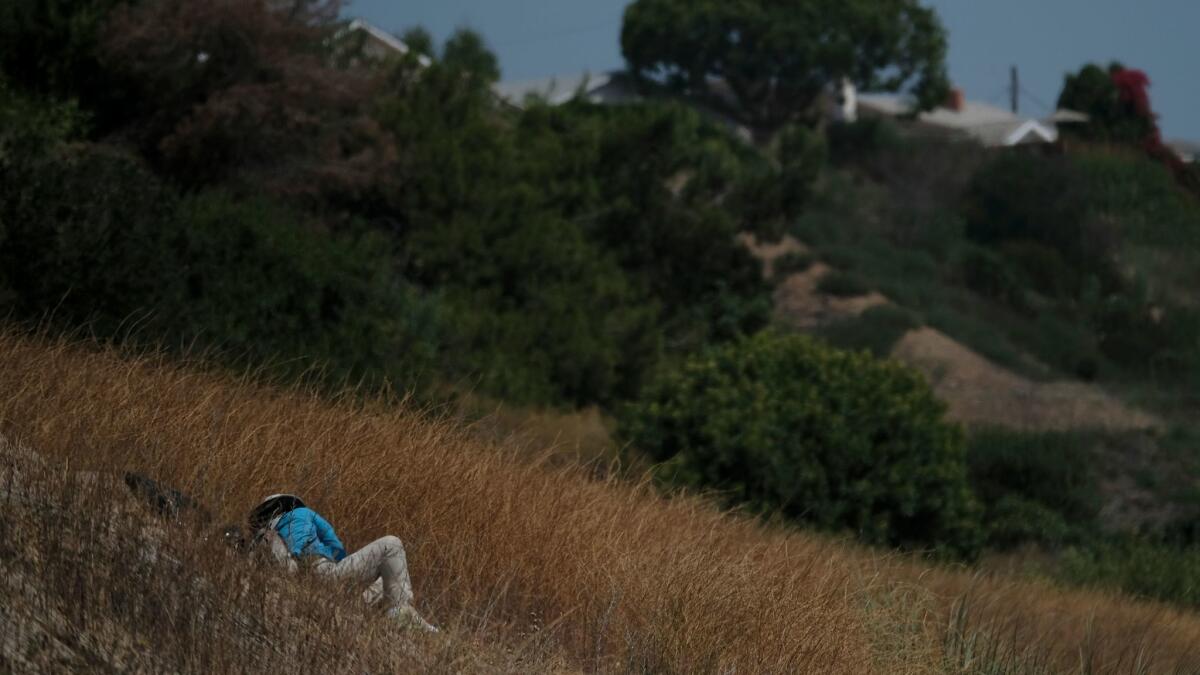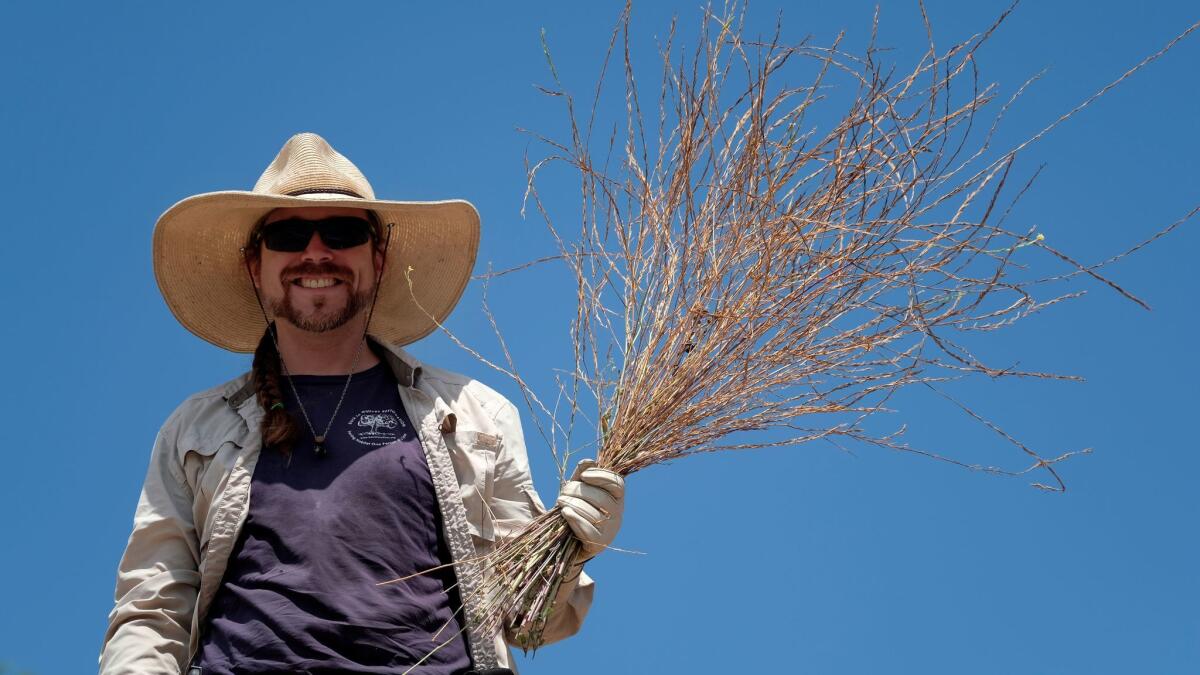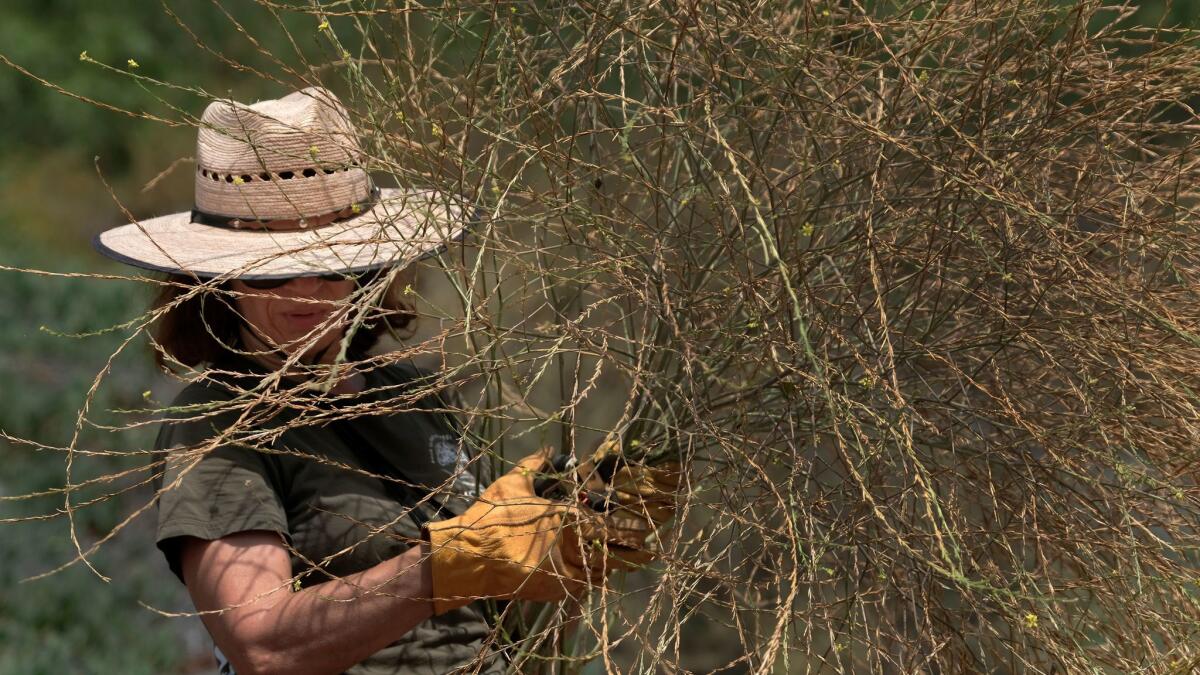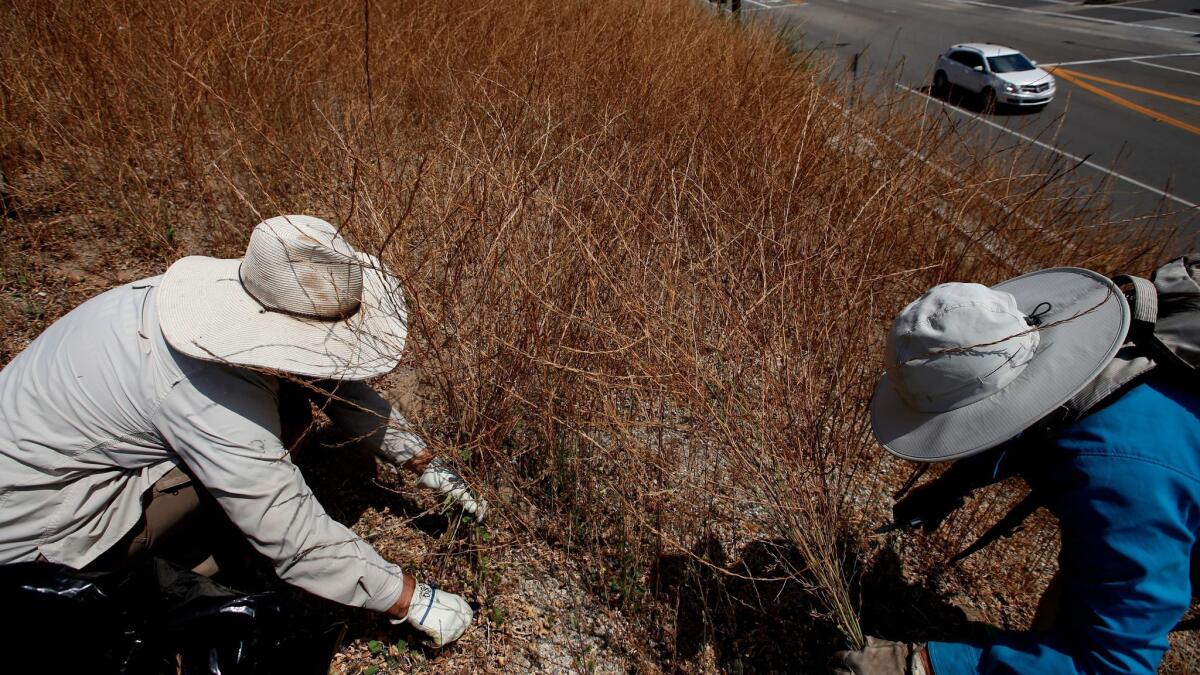Hold the mustard: In Orange County land reserve, an unwelcome guest sprouts among native plants

On a recent Sunday morning, Reginald Durant led a dozen volunteers through an Orange County nature reserve draped in a gentle down of marine layer and pointed out plants with fanciful names like fiddleneck, coast goldenbush and tidy tips.
Walking further, the group passed coastal prickly pear, bladderpod, elderberry and golden yarrow.
But this was no ordinary hike. Durant and his volunteers were on a seek-and-destroy mission — and their target was a plant with a decidedly plain name.
Mustard overran the Cuesta Kato Native Land Reserve in Dana Point as a result of above average rainfall last winter.
Because it is considered susceptible to fire, the city had the authority to clear the entire site — something Durant wanted to avoid.
So he gathered up volunteers to perform the task of pulling the relentless mustard by hand.
“The natives would not recover from being mowed and it would be type-converting it to nonnative annual thatch, which would then be a direct fire threat to this area,” said Durant, the founder and executive director of the nonprofit group Back to Natives.

Dana Point’s weed abatement program never explicitly defines “clear and abate” as mowing an entire site. But city officials say that is the most economical option.
“Mowing/weed-eating is usually the cheapest. Hand-pulling weeds, among other methods, are more expensive,” said City Manager Mark Denny. “Ultimately, the property owner will bear the cost of the removal, so we generally try and do it the cheapest way possible.”
Experts say it is difficult for some native plants, especially young ones, to survive a mow. But it varies by plant.
“If they planted [California] grassland or prairie species, then mowing at this time of year shouldn’t harm the natives,” said Sarah Kimball, an assistant project scientist for the Center Environmental Biology department at UC Irvine. “If they planted coastal sage scrub shrub species recently, then I would ask the city to mow around them. Those natives won’t do well with mowing. If native shrubs have been established for many years, then they may crown-sprout following mowing, especially if it is done as high as possible.
“The mowing would still be an additional stress on the native shrubs, and many wouldn’t survive,” Kimball added.
The land reserve provides native seeds for the nonprofit’s nursery in Santa Ana. The group also hopes to create trails on the land and use the land for educational purposes.
Back to Natives received a notice from Dana Point in February to destroy the mustard, which is a weed. Since March, the group has gone to the reserve with volunteers from 9 a.m. to noon every Sunday to hand clip each piece of mustard. But the effort took longer than desired because there were not enough volunteers.
“It makes sense to remove the invasive and replace with lower-fire-hazard natives,” Denny said. “The city and the property owner both agree that is the best outcome. The challenge is how quickly that can be done.”

The group had a bit more time to work with since the Santa Ana winds that often fan fires in the fall don’t affect this area as much as others, said Jim Randerson, a professor for the Department of Earth System Science at UC Irvine.
“Santa Ana fire season is most intense in September through early November,” Randerson said. “But Santa Ana fire risk is mostly confined to high-wind corridors downwind of mountain passes, and I don’t believe Dana Point is downwind of one of these classic high-wind corridors.”
Phil Rundel, a professor of the Department of Ecology and Evolutionary biology at UCLA, said the mustard can be removed before it goes to seed to prevent a recurrence next year.
“Mustard can be hand-weeded when small but is more difficult to pull once it gets larger,” Rundel said. “If it is thickly established, the city may be correct in deeming it a fire hazard that needs clearing. In any case, it is important to get the mustard removed before it produces new seed.”
Carla D’Antonio, a professor at UC Santa Barbra who specializes in plant and ecosystem ecology, invasive species and restoration ecology, does not consider mustard to be particularly ignitable.
“To me, the biggest issue with mustards is that they exude chemicals that inhibit other species,” she said. “So the Back to Natives folks should get rid of the mustard to keep it from inhibiting the natives. It will take over their site if they don’t keep it back.”
When Durant met recently with volunteers at an Albertson’s parking lot, he made sure everyone sanitized the bottom of their shoes so that no one tracked nonnative seeds into the site.
After a brief orientation in the parking lot, Durant took the volunteers and showed off the site’s coast goldenbush, which sprouts yellow flowers from long, green stems. The fiddleneck’s stem looks furry, with tiny hairs growing on its spiraling neck where yellow flowers bloom.
Tidy tips are yellow flowers with white-tipped petals that give them the look of tiny sunbursts. Bright colors from the green grass and yellow, white, and pink flowers fill the land, with hints of purple from native grass.
The native milkweed serves monarch butterflies, which lay their eggs on it. The blooming flowers attract a globally dwindling population of bees. Hummingbirds, hawks and field mice have been spotted on the land. Fox footprints have also been seen.
But if one did not venture deep into this sloped land and simply drove past on Del Obispo Street, they might not have noticed much of any of this, because of a blanket of brown, dry mustard.

As Durant walked through the land, he went out of his way not to disturb an orb weaver spider that had spun a large, circular web in the mustard. The volunteers pulling the mustard left this small patch undisturbed, at least for a little while.
Their efforts might have paid off — for now. Durant and the volunteers have made progress removing the mustard. Over the weekend, Durant informed the city that he believes that the group has cleared the site.
Weed abatement is an annual program for the city. At the beginning of next year, city staff will identify properties that require weed abatement.
“Over time, if Back to Natives is successful in type-conversion of the weeds on their property from high-fire-hazard invasive weeds like mustard to lower-fire-hazard native shrubs, it is possible that the property won’t be identified for weed abatement efforts,” Denny said.
Until that time, Back to Natives must continue to keep the mustard under control — and make sure the city is satisfied with their progress.
ALSO
A woman fights to save her rhinos armed only with her grandmother’s shotgun
High-water year makes Pacific Crest Trail a more treacherous hike
Round 2: Monsoonal moisture to bring more wild weather and thunderstorms to Southern California
More to Read
Start your day right
Sign up for Essential California for news, features and recommendations from the L.A. Times and beyond in your inbox six days a week.
You may occasionally receive promotional content from the Los Angeles Times.







